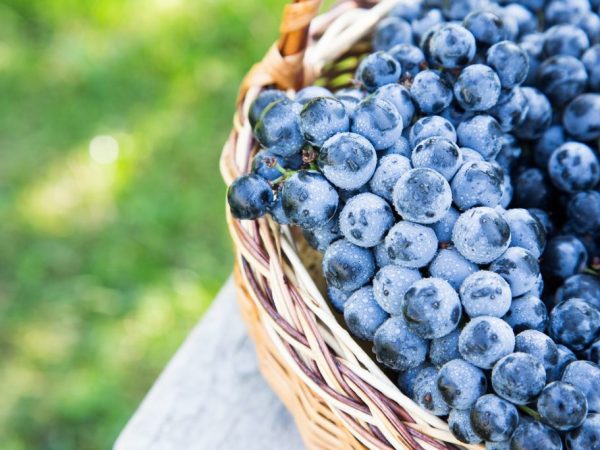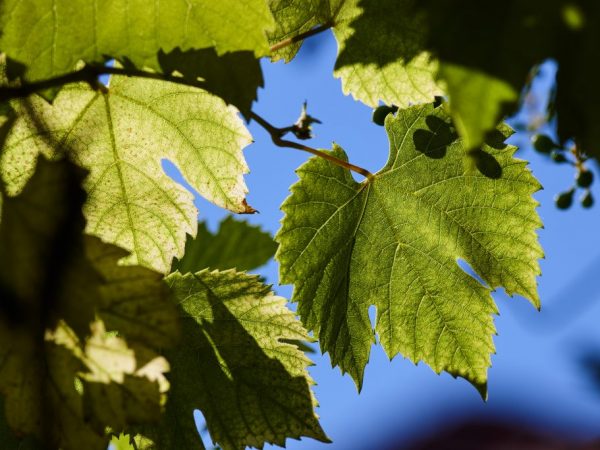Mukuzani grape cultivation
Mukuzani grapes appeared on the market several years ago. It belongs to wine cultures. This hybrid is considered uncovering, it is often planted in areas as an ornamental plant.

Mukuzani grape cultivation
Plant features
The Mukuzani hybrid grape has an early ripening period. When this variety is grown in the central regions of the country, the harvest takes place at the beginning of August, in the northern regions - at the end of September.
Bush characteristic
The average height of the Mukuzani grape bush is 4 m. According to the description, the leaves have both 3 and 5-lobed structure. The sections on the surface of the sheet plate are deep. It is covered with a rough layer. The shape of the leaf is round.
Flowering occurs with the help of bisexual flowers, which positively affects the possibility of self-pollination and further yield indicators. Shoots are developing well. Each forms 4 large clusters.
Description of the fetus
The bunches are conical, medium in size. According to the description of Mukuzani grapes, their average weight is 700-800 g.
The berries are small. Each has a weight of 3 g. The rind is dense, thick, bright blue. Each berry contains a small amount of small seeds. The pulp is firm and crispy.
The fruits do not crack or fall off when overripe, so they are often harvested several weeks later than the due date. This makes them sweeter.
Growing rules
It is better to grow the Mukuzani grape variety in sunny areas. This will help the fruit ripen quickly and enhance its sweet taste. The south side is ideal. In terms of soil, the variety is unpretentious. The only requirement is protection from wind and drafts, so planting is carried out near hedges or gazebos.
Seedlings are bought at the end of winter, until they are planted, they are stored in containers. The root system of the plant is poorly developed, so planting is carried out directly in them, removing only the bottom. The end of March is considered the optimal time for planting, but it is better to prepare the holes from November. To do this, they dig up the entire area, 2 buckets of humus are brought in for each square meter.
The planting hole is dug before frost. Its dimensions should be 70x70 cm. A drainage system is installed at the bottom so that groundwater does not disturb the development of roots.
In the spring, a seedling is placed inside the hole. Its optimal height should be 1.2 m. The root part is sprinkled with earth. After that, a shallow circular trench is made around the seedling, intended for watering. A support is installed nearby, to which the planting material is tied. The distance between the rows should be 2 m, and between the bushes - 3 m.
Care rules

The variety needs mandatory fertilization
The Mukuzani grape variety is unpretentious in care. He only needs high-quality feeding. The first fertilizers are applied only the next year after planting. This will give the plant time to form naturally.In the spring, 20 liters of superphosphate solution is added under the root (20 g is diluted in 10 liters of warm water). At the time of fruiting, the bushes are fed with 15 liters of ammonium nitrate solution (10 g per 5 liters of warm water). In autumn, the plant does not need to be prepared for winter, so it is enough to mulch the top layer of the earth with humus.
All weeds are removed prior to irrigation. After that, the top layer of the soil is loosened to a depth of 10 cm. Water the Mukuzani grape variety after lunch, using water at room temperature. Watering is carried out at intervals of 25 days, 15 liters of water are poured under each bush.
The Mukuzani grape variety does not need pruning: its crown is already rare. The more vines on it, the better it will look around the gazebo. Dry branches must be removed.
Common diseases and pests
Among the diseases, the following are distinguished:
- Downy mildew. In the fight against it, a solution of Bordeaux liquid is used (20 g per 5 liters of water).
- Gray rot. A solution of copper sulfate (10 g per 5 liters of water) helps to fight it.
- Fruit rot. Treatment with khomus (30 g per 5 liters of water) helps against it.
Pests include birds, wasps and aphids. Special dense nets, which enclose the bushes, help to get rid of birds. Special mesh bags are the salvation from wasps. They are put on each bunch of the bush. As a fight against aphids, an oxychoma solution is used (10 g per 3 liters of water).
Conclusion
The Mukuzani wine variety has become popular due to its high yields. It is easy even for beginners to care for this grape variety, which makes it even more in demand.


